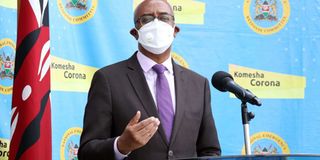120 more contract coronavirus raising Kenya cases to 6,190

Health Chief Administrative Secretary Rashid Aman during a past Covid-19 briefing at Afya House, Nairobi. PHOTO | DENNIS ONSONGO | NATION MEDIA GROUP
What you need to know:
- The Health ministry announced this on Monday, saying it had tested 2,221 samples.
- Chief Administrative Secretary (CAS) Rashid Aman also announced the recovery of 42 more patients, raising the number of recoveries to 2,013.
A hundred and twenty more people have tested positive for the coronavirus in Kenya, raising the country’s total number of confirmed cases since March 13 to 6,190.
The Health ministry announced this on Monday, saying it had tested 2,221 samples.
Chief Administrative Secretary (CAS) Rashid Aman said all but five of the new patients are Kenyans and that the youngest is six and the oldest 83.
Nairobi, the capital city, was in the lead with 67 of the cases. Mombasa County followed with 17 and then came Machakos and Kajiado with nine each, Kiambu eight, Uasin Gishu four and Nakuru, Kilifi and Narok with two each.
In Nairobi Westlands had 12 cases, Dagoretti North and Lang'ata 11 each, Kibra six, Makadara and Starehe four each, Kamukunji three, Embakasi Central, Embakasi East, Embakasi North, Embakasi South, Embakasi West and Mathare to each, Kasarani, Roysambu, Ruaraka and Umoja one each.
In Mombasa, Mvita recorded six cases, Jomvu five, Changamwe, Kisauni and Likoni two each.
Dr Aman also announced the recovery of 42 more patients, raising the total number of recoveries to 2,013.
He said the death toll had risen to 144 as one more patient had died.

RESEARCH
According to the Health ministry, Covid-19 has infected at least 9,962,193 people globally and caused more than 498,723 deaths.
Regarding the spread of the disease across Kenya, Dr Aman said "it is only a matter of time before all the counties record a case".
Regarding efforts to contain the spread, Dr Aman said the Ministry of Health and the Kenya Medical Research Institute (Kemri) are conducting more research.
The research, he said, is focused on local characterisation of the pandemic to determine who are affected, where and how; understanding the disease spectrum and characterisation of the outcomes - who are asymptomatic, who are developing symptoms, the severity and fatalities; and interventions implemented and their levels of success.





